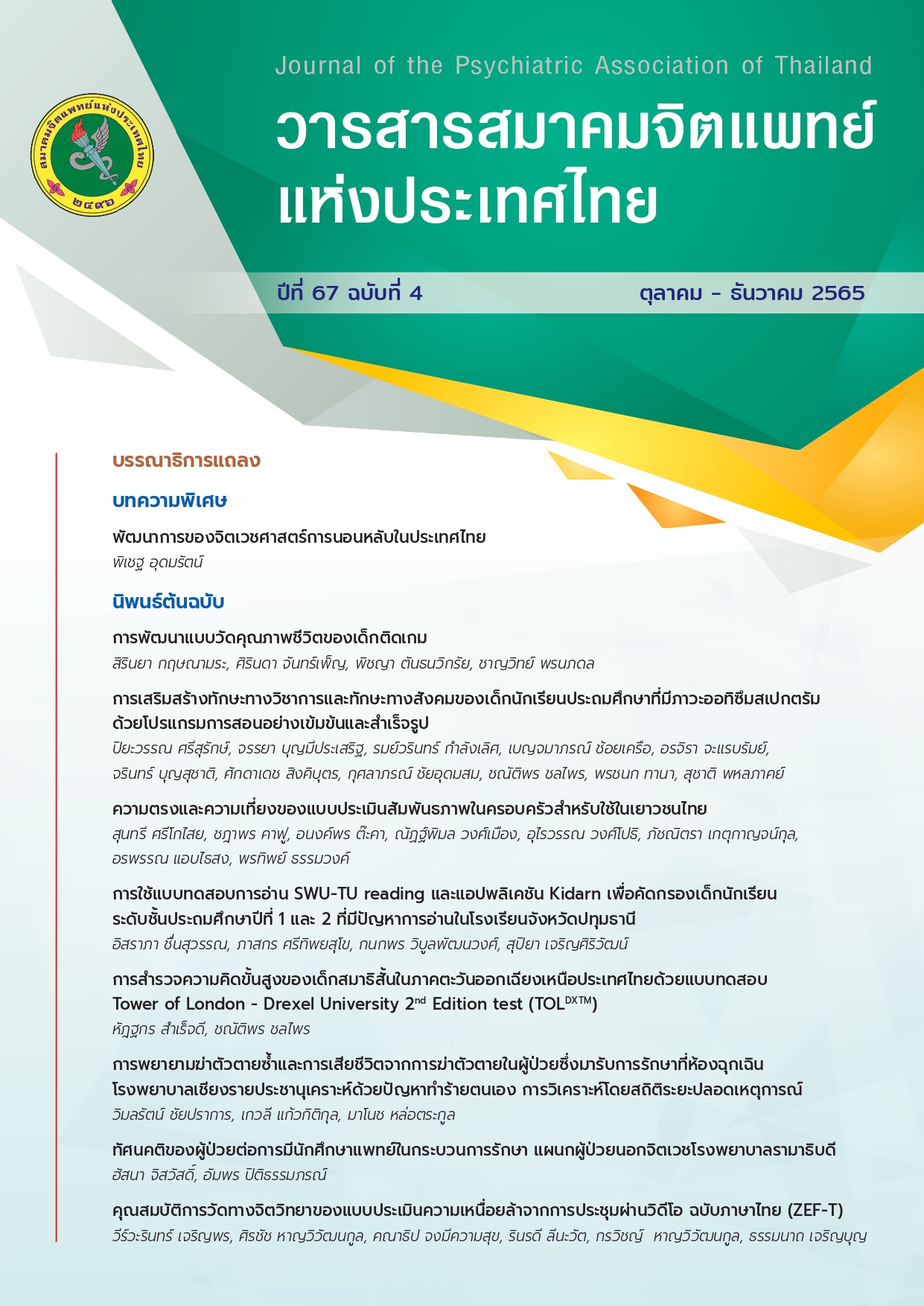A survey of the executive functions of children with ADHD in the Northeast of Thailand using Tower of London – Drexel University 2nd Edition test (TOLDXTM)
Main Article Content
Abstract
Objective: To study executive functions of ADHD children aged between 7 - 10 and 11 - 15 and ADHD children who take medication and did not take medication in the Northeast of Thailand.
Methods: This was a cross-sessional study. The data was collected from a total of 83 children aged between 7 - 10 and 11 - 15 years old who were diagnosed with ADHD at the psychiatric unit at Srinagarind hospital, faculty of medicine Khon Kean University during December 1, 2021 – July 30, 2022. The executive functions were assessed using the Tower of London - Drexel University 2nd Edition test (TOLDXTM). Data were analyzed using mean score and independent t-test statistics.
Results: The total move score was 88.41 (SD=16.80), the total correct score was 87.52 (SD=13.11), the total rule violation was 94.05 (SD=16.82), the total initiation time was 96.14 (SD=12.63), the total execution time was 95.11 (SD=15.59) and the total problem-solving time was 96.84 (SD=15.65). Moreover, the children group aged between 7 - 10 years outperformed the group 11 - 15 years to a statistically significant level (p-value=0.003) in moving beads score.
Conclusion: ADHD children in the Northeast of Thailand had a low average level of executive functions.
Article Details

This work is licensed under a Creative Commons Attribution-NonCommercial-NoDerivatives 4.0 International License.
Articles submitted for consideration must not have been previously published or accepted for publication in any other journal, and must not be under review by any other journal.
References
American Psychiatric Association. Diagnostic and statistical manual of mental disorders (DSM-5®). American Psychiatric Pub; 2013.
Castellanos FX, Proal E. Large-scale brain systems in ADHD: beyond the prefrontal–striatal model. Trends Cogn Sci 2012; 16(1) :17–26.
Liston C, Matalon S, Hare TA, Davidson MC, Casey BJ. Anterior cingulate and posterior parietal cortices are sensitive to dissociable forms of conflict in a task-switching paradigm. Neuron 2006; 50(4): 643–53.
Rubia K. ADHD brain function. Oxford Textb Atten Deficit Hyperact Disord 2018; 64.
Roman-Urrestarazu A, Lindholm P, Moilanen I, Kiviniemi V, Miettunen J, Jääskeläinen E, et al. Brain structural deficits and working memory fMRI dysfunction in young adults who were diagnosed with ADHD in adolescence. Eur Child Adolesc Psychiatry 2016; 25(5): 529–38.
Bock J, Breuer S, Poeggel G, Braun K. Early life stress induces attention-deficit hyperactivity disorder (ADHD)-like behavioral and brain metabolic dysfunctions: functional imaging of methylphenidate treatment in a novel rodent model. Brain Struct Funct 2017; 222(2): 765–80.
Doyle AE. Executive functions in attention-deficit/hyperactivity disorder. J Clin Psychiatry [Internet] 2006; 67 Suppl 8:21–6. Available from: http://europepmc.org/abstract/MED/16961426
Brown TE. Attention deficit disorder: The unfocused mind in children and adults. Yale University Press; 2005.
Brown TE. Executive functions and attention deficit hyperactivity disorder: Implications of two conflicting views. Int J Disabil Dev Educ 2006; 53(1): 35–46.
Diamond A. Executive functions. Annu Rev Psychol 2013; 64: 135–68.
Rosen AC, Gur RC. Ethical considerations for neuropsychologists as functional magnetic imagers. Brain Cogn 2002; 50(3): 469–81.
Zakzanis KK, Mraz R, Graham SJ. An fMRI study of the Trail Making Test. Neuropsychologia 2005; 43(13): 1878–86.
Binder JR, Sabsevitz DS, Swanson SJ, Hammeke TA, Raghavan M, Mueller WM. Use of preoperative functional MRI to predict verbal memory decline after temporal lobe epilepsy surgery. Epilepsia 2008; 49(8): 1377–94.
Barkley RA. Neuropsychological testing is not useful in the diagnosis of ADHD: Stop it (or prove it)! ADHD Rep 2019; 27(2): 1–8.
Jullagate S, Wisessathorn M, Patcharoros N. The comparative study of executive function between children with ADHD and healthy children. J Psychiatr Assoc Thai 2019; 64(2): 187–96.
Culbertson WC, Zillmer EA. The Tower of London(DX): a standardized approach to assessing executive functioning in children. Arch Clin Neuropsychol 1998; 13(3): 285–301.
Culbertson WC. Tower of London - Drexel University (TOL - DX) : technical manual. Second edition. Zillmer EA, editor. Toronto: MHS; 2005.
Culbertson WC, Zillmer EA. The construct validity of the Tower of London DX as a measure of the executive functioning of ADHD children. Assessment 1998; 5(3): 215–26.
Chaimaha N, Sriphetcharawut S, Lersilp S, Chinchai S. Effectiveness of therapeutic programs for students with ADHD with executive function deficits. J Occup Ther Sch Early Interv 2017; 10(4): 436–56.
Chirawatkul A. Statistic for health science research. 4th ed. Bangkok: Witthayaphat Co.,Ltd; 2558.
Romine CB, Reynolds CR. A model of the development of frontal lobe functioning: Findings from a meta-analysis. Appl Neuropsychol 2005; 12(4): 190–201.
Yasumura A, Omori M, Fukuda A, Takahashi J, Yasumura Y, Nakagawa E, et al. Age-related differences in frontal lobe function in children with ADHD. Brain Dev 2019; 41(7): 577–86.
Lumsdaine E, Lumsdaine M. Creative problem solving. IEEE Potentials 1994; 13(5): 4–9.
Kaufman JC, Baer J. Creativity and reason in cognitive development. Cambridge University Press; 2006.
Mechler K, Banaschewski T, Hohmann S, Häge A. Evidence-based pharmacological treatment options for ADHD in children and adolescents. Pharmacol Ther 2022; 230: 107940.
Hernández GGC, Selva JPS. Medication and creativity in attention deficit hyperactivity disorder (ADHD). Psicothema 2016; 28(1): 20–5.


